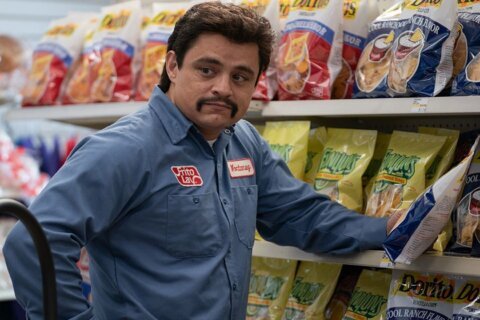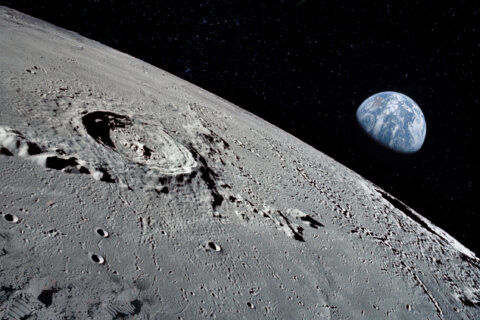Jason Fraley, WTOP film critic
NOTE: I have now seen “The Dark Knight Rises” twice. The first viewing was during a pre-screening at the Smithsonian Museum of Natural History, which inspired the following review, posted prior to the horrific movie theater massacre that killed 12 and wounded dozens more in Aurora, Colorado.
Despite the tragedy, moviegoers went on with their lives without fear, turning out to theaters in record numbers, and giving “The Dark Knight Rises” the biggest opening in 2D movie history. I joined them at the Uptown Theater for a literal block-buster down Connecticut Ave. NW. The shared experience of a sold-out crowd, clapping and cheering together, reminded me of two quotes.
The first is from ‘Batman’ character Harvey Dent, Gotham’s District Attorney: “The night is darkest just before the dawn. And I promise you, the dawn is coming.”
The second is from director Christopher Nolan: “I believe movies are one of the great American art forms and the shared experience of watching a story unfold on screen is an important and joyful pastime. The movie theater is my home, and the idea that someone would violate that innocent and hopeful place in such an unbearably savage way is devastating to me. Nothing any of us can say could ever adequately express our feelings for the innocent victims of this appalling crime, but our thoughts are with them and their families.”
WASHINGTON – “The night is darkest just before the dawn. I promise you, the dawn is coming.”
If “The Dark Knight” was the darkest night, “The Dark Knight Rises” is the dawn.
Perhaps I’m more a fan of the grittier DC Comics than the fantastical Marvel product. Or, maybe I was relieved that “Rises” didn’t have malfunctioning 3D glasses like my screening of “The Avengers.”
But after watching the two biggest superhero blockbusters of the summer, I have come to one conclusion: Joss Whedon just got served by Christopher Nolan.
While Whedon’s “Avengers” was intensely forward-looking, Nolan remembers where his franchise came from, calling back to its predecessors while introducing compelling new elements. I highly recommend watching the first two again before you head to the theaters. In “Batman Begins” (2005), pay close attention to Ra’s Al Ghul, the League of Shadows, and shots looking up from the bottom of a well. In “The Dark Knight” (2008), brush up on the Harvey Dent Act.
This primer will help you better grasp “The Dark Knight Rises,” which picks up eight years after Batman took the fall for District Attorney Harvey Dent, whose “Two-Face” murders were concealed in order to keep Dent a symbol of hope for Gotham City. Bruce Wayne (Christian Bale) has retired from crime-fighting, until the cat burglar Seline Kyle a.k.a. Catwoman (Anne Hathaway) and beastly anarchist Bane (Tom Hardy) threaten to topple Gotham’s class structure with extreme violence.
Like all good sequels, the old dogs must learn new tricks. “The Dark Knight Rises” does this with killer new technology, fresh set pieces and compelling new characters.
Nolan continues the trend of introducing new Bat vehicles for each film. Just as “Batman Begins” brought the Batmobile and “The Dark Knight” the Batcycle, the third installment brings the Bat aircraft, zipping around skyscrapers and firing powerful ammo.
Batman needs the new tech to counter the destruction of Nolan’s magnificent set pieces, from the airplane opener, to an exploding football field, to an icy harbor where Gotham officials are exiled to death by a former Batman villain (cameo).
As for the new characters, Anne Hathaway is a stunning Catwoman, exactly 20 years after Michelle Pfeiffer played the role in “Batman Returns” (1992). Equal parts sexy and kickass, Hathaway uses her femininity to trick people into pity, then uses her skills to pick their pockets and break their necks.
The film also introduces two new characters from Nolan’s “Inception” stable. Oscar-winner Marion Cotillard plays Miranda Tate, a board member of Wayne Enterprises, and Joseph Gordon-Levitt plays John Blake, an idealistic cop who has the fanboys chanting, “Holy sequel, Batman!” (NOTE: A second viewing will allow you to better appreciate the setups and payoffs in this regard)
Most memorable is Tom Hardy’s Bane, last played in “Batman and Robin” (1997) by WCW wrestler Jeep Swenson. Here, he more resembles the WWF’s “Kane,” a back- breaking brute who wears a mask over a scarred face and speaks with a voice filter. The echo of his voice will scare the hell out of you, but it can be hard to understand, depending on the volume in the movie theater.
The Bane character raises the film’s most fascinating debate: Batman as an allegory for Campaign 2012. Republicans will link the evil forces to Occupy Wall Street, swarming the Gotham Stock Exchange with violent “class warfare,” while Democrats hope the villain Bane will remind viewers of Mitt Romney’s Bain Capital. As Hathaway tells billionaire Bruce Wayne, “You think this can last. There’s a storm coming, Mr. Wayne. You and your friends better batten down the hatches. ‘Cause when it hits, you’re all going to wonder how you ever thought you could live so large, and leave so little for the rest of us.” I suppose such a debate is fitting for a comic brand named “DC.”
Only Nolan, brother Jonathan and co-writer David S. Goyer know the script’s true intentions. But the very existence of this debate shows why Nolan’s Batman trilogy works. They’re not just movies; they’re larger-than-life metaphors for justice, crime and finding hope in supposed lost causes. Gotham might as well be New York City, Rome or Constantinople, great empires on the brink of self-destruction.
The people of Gotham — a collection of “haves and have nots” — are what make Nolan’s trilogy much deeper than “The Avengers,” where the mortals are mere collateral. Ants running around beneath the crumbling buildings of superheroes (Robert Downey Jr. is the one welcome exception). In Nolan’s saga, the humans are thoroughly woven into the story’s moral fabric. In “Batman Begins,” Bale battles Neeson on the very public transit system his father built to help low-income residents. In “The Dark Knight,” The Joker piles citizens into two ferry boats to see which will blow the other up first.
The third installment continues this trend, allowing Gotham’s inmates to run the asylum and fleshing out mortals, including Commissioner Gordon (Gary Oldman), Alfred Pennyworth (Michael Caine) and Lucius Fox (Morgan Freeman). Even the “superheroes” come from real places: Catwoman is a cat burglar; Bane and Batman are products of troubled childhoods. “The Dark Knight Rises” further explores Bruce Wayne’s inner turmoil, taking him to a literal breaking point and daring him to “rise.” As his father once taught him, “Why do we fall? So we can learn to get back up.”
The “getting up” line is fitting for Bale’s first Batman role since winning the Oscar for “The Fighter” (2010). My one gripe throughout the whole series has been his phony deep voice when behind the mask. While the need to disguise his voice is realistic, Bale’s interpretation takes us out of the movie from time to time. As a physical specimen, however, he’s a much more fitting hero than Adam West, Michael Keaton, Val Kilmer or George Clooney.
His underground battle with Bane is larger-than-life, especially in IMAX. Nolan shot 72 minutes of the film in IMAX, a lot compared to most movies, like the 25 minutes in “Mission Impossible: Ghost Protocol.” Frustratingly, “The Dark Knight Rises” shifts back and forth between the expanded IMAX vertical image and the standard 35 millimeter letterbox format. I’m not sure how I feel about these shifting of these aspect ratios. If done with a purpose, it might seem like bold, experimental filmmaking. If random, it’s moderately distracting. I’m willing to withhold judgment until second viewing.
Until then, many will weigh the third installment’s merits against the previous two. In the land of the trilogies, Nolan’s Batman saga resembles “Star Wars” with a powerful intro, masterpiece middle and a third effort that, while the weakest of the three, ties up the series and leaves room for more movies. (NOTE: Having seen the movie again, it’s every bit as good as the previous two)
The middle piece, “The Dark Knight,” remains the crown jewel of Nolan’s Batman triple crown, featuring the series’ best villain, The Joker, underscored by Heath Ledger’s tragic death and posthumous Oscar. I’ll go one step further. “The Dark Knight” will represent this entire comic book generation, from “The X-Men” in 2000 to “The Avengers” in 2012.
If “The Dark Knight” was a 4-star action masterpiece, “The Dark Knight Rises” is just a cut below. But by clocking in at nearly three hours, it allows itself the time to wrap up the series properly. Hollywood will no doubt return to Gotham, probably sooner than we’d like, but as the Batcave’s mechanical lift rises to cover the screen in the final shot, Nolan bows out gracefully.
★ ★ ★ 1/2
The above rating is based on a 4-star scale. Read more from WTOP Film Critic Jason Fraley by clicking ” Fraley on Film” under the “Living” tab above, following @JasonFraleyWTOP on Twitter, and checking out his blog, The Film Spectrum.
(Copyright 2012 by WTOP. All Rights Reserved.)








